Acer circinatum 'Pacific Fire'
VINE MAPLE, PACIFIC FIRE VINE MAPLE, SCARLET BARK VINE MAPLE
SFamily: Aceraceae
Pronounced: A-ser sir-sin-Ah-tum
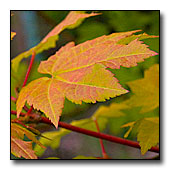
Quick Jumps
Growing Guide
Rainy Side Notes
GROWING GUIDE
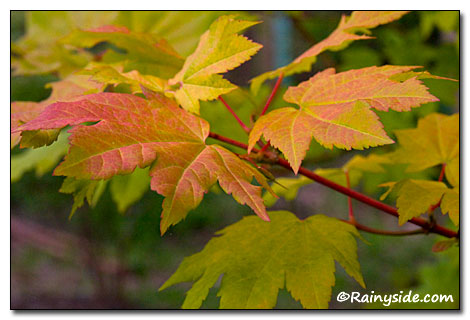
Origin:
Garden.
Plant Group:
Trees.
Hardiness:
Sunset zones: A3; 2b-6, 14-17
USDA zones: 6-9.
Heat zones: 9-4.
Mature size:
Height: 12 feet (3.6 m).
Width: 12 feet (3.6 m).
Flowering period:
Spring.
Flowering attributes:
Umbels of reddish purple sepals and white petals make up the small flowers, followed by winged red fruits.
Leaf attributes:
Mid-green leaves, 5-9 lobed and 2-5 inches. In spring the leaves open yellow with hints of orange, turning green for summer and in fall turning brilliant yellow with hints of orange.
Light:
Partial to full shade.
Soil:
Moist, humus rich soil.
Feeding:
Side dress with compost to add humus to the soil and help retain moisture.
Propagation Methods:
Softwood cuttings. They are difficult to root and plants sold are normally grafted onto vine maple roots.
Pruning Methods:
Prune in late autumn to mid-winter.
Verticillium wilt may be a problem.
Rainy Side Notes
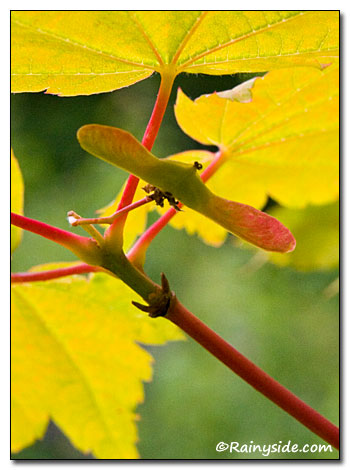
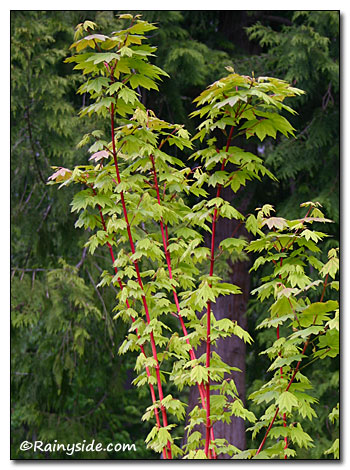
Oh does this Acer 'Pacific Fire' hate full sun! The leaves crisp up in protest when the waves of intense sun hit in July.
First, let me back up a little and give some backstory about this tree in my garden. When I first acquired it, I wanted to grow it in in a large ceramic pot for a few years, before I embedded it in the ground. I under-planted the tree with violas for many years and enjoyed its contained growing in my courtyard. Meanwhile, the tree kept growing and a few years, turned into seven.
The pot had a skinnier rim then the full width of the container, something I was aware of when I planted the little tree. I had good intentions of taking it out sooner, so I didn't believe it would be a problem. Philip Bloomquist, a professional gardener who helps me with my plot of land, came to my aid and we tipped the heavy container on its side.
Imagine the struggle we had freeing the tree, since the roots had completely filled that pot! We worked on removing the maple from its prison for four long hours. We slowly whittled the roots away in order to fit them through the opening of the container by using the jet-spray setting on a hose nozzle, and allowing the water to help us dig and slice our way straight down from the rim. Both of us were ready to bust the tree out with dynamite as we struggled, poked, prodded, cut, and hosed those roots! During the process I said a few colorful words, while the ever-so-polite Philip recommended planting bamboo in the soon-to-be empty pot—anything but a tree. He repeated the recommendation more than a few times.
When the maple was finally free, we planted it in the garden in full sun, even though I knew it wouldn't like the position very well. However, there is a birch tree (Betula 'Royal Frost') nearby that will grow tall enough to provide dappled shade in a few more years. I suspect if I gave the vine maple more water it would handle the sun better, as they thrive best in moist soils around seepages and near waterways.
I pruned mine to be a single trunk specimen instead of multi branching. The lichen is beginning to cover the branches and trunk adding another dimension to this delightful cultivar. The spring green-yellow leaves turn green in summer and then a brilliant yellow with hints of orange for fall, which contrasts with the beautiful red twigs.
Nine years later, and two years after transplanting into the ground, it is settling into its home and I enjoy the glossy red bark in winter, which is similar to but surpasses the coral red hues of the coral bark maple (Acer palmatum 'Sango-kaku'), which grows nearby.
If you have room for only a single small tree, I highly recommend this cultivar of our beloved Pacific Northwest native vine maple.
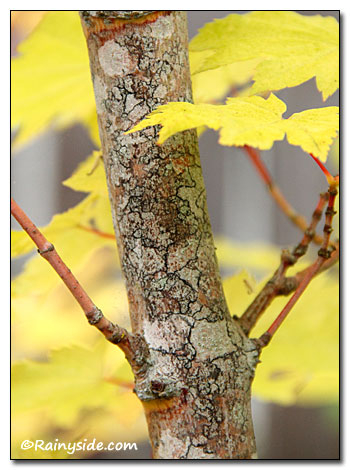
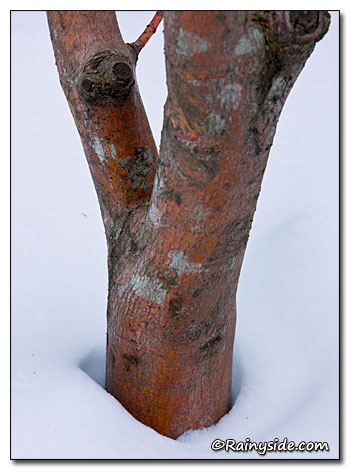
Photographed in author's garden.
A Pacific Northwest Plant of the Week (2013)

Gardening for the Homebrewer: Grow and Process Plants for Making Beer, Wine, Gruit, Cider, Perry, and More
By co-authors Debbie Teashon (Rainy Side Gardeners) and Wendy Tweton

